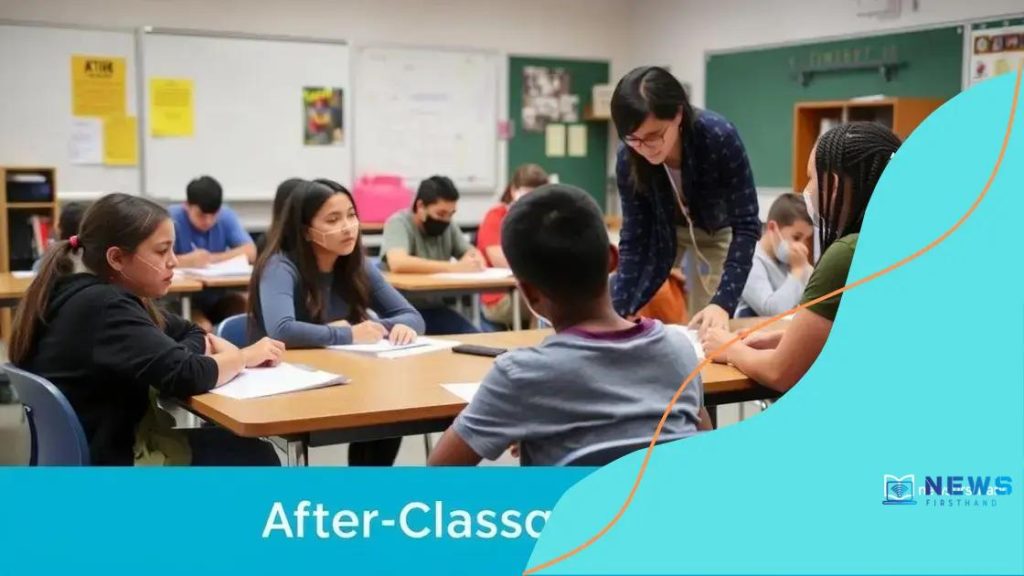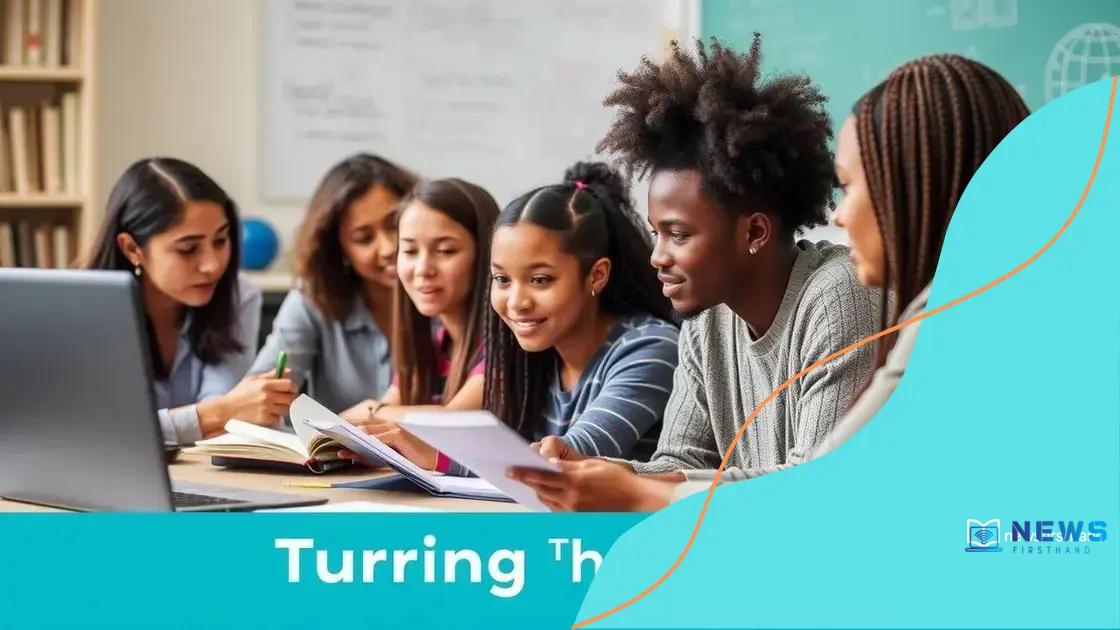Federal funding support for after-class tutoring

Federal funding support for after-class tutoring enhances student learning by providing resources for personalized academic assistance, ultimately improving grades and engagement in school.
Federal funding support for after-class tutoring plays a crucial role in helping students who need extra help outside regular school hours. Have you ever wondered how these programs improve learning outcomes? Let’s explore.
Understanding federal funding programs
Understanding federal funding programs is essential for educators and school administrators. These programs provide vital resources to enhance student learning, especially in after-class tutoring.
One major aspect of these funding programs is their broad scope. They aim to support various educational needs across multiple regions, improving academic performance overall.
Types of Federal Funding Programs
Several types of funding are available, each catering to different educational challenges. Schools can access money for specific tutoring programs and initiatives. Here are some key types:
- Title I Funding: This program assists schools with high numbers of low-income students.
- 21st Century Community Learning Centers: These centers provide after-school programs focused on academic enrichment.
- Special Education Grants: Funding dedicated to helping students with disabilities.
These programs enable schools to implement targeted tutoring services, making learning accessible and effective for all students.
Besides the types of programs available, it’s also important to understand how funds are distributed. Generally, federal funds are allocated based on factors like the number of eligible students and specific needs of the school district. Schools must apply and demonstrate how they plan to use the funding to improve student performance.
Applying for Federal Funding
The application process can seem complex, but it allows schools to showcase their commitment to enhancing education. Schools typically must provide:
- A clear plan outlining how the funds will be used.
- Data supporting the need for additional resources.
- Evident goals for academic improvement.
This application process not only secures funding but also encourages schools to reflect on their educational strategies.
As schools successfully integrate these programs, the potential for enhanced student outcomes becomes clearer. By effectively utilizing federal funding, schools can provide invaluable after-class support, benefiting students who need it most.
Eligibility criteria for funding
Eligibility criteria for funding play a crucial role in ensuring that resources go to schools that need them the most. Understanding these criteria helps educators and administrators navigate the application process effectively.
Typically, funding eligibility is based on several factors. Schools must demonstrate financial need, especially in areas with high numbers of low-income students. This connection to socio-economic conditions is important because it ensures that the funds provide support where it is most required.
Key Eligibility Factors
When applying for federal education funds, schools should be aware of specific criteria. Here are some of the main factors:
- Student Demographics: Schools serving a significant percentage of low-income families qualify for many funding opportunities.
- Academic Performance: Schools showing low academic achievement may be prioritized for funding.
- Program Type: Some funds are earmarked for particular programs, like after-school tutoring or special education.
Schools must be prepared to provide documentation showing they meet these eligibility factors. This can include data on student performance and demographics.
In addition to these factors, it’s also essential for schools to have a clear plan for how they intend to use the funds. Demonstrating a comprehensive proposal can significantly enhance a school’s chances of receiving funding. This plan should outline the programs that will be implemented and their expected impact on student performance.
Understanding these eligibility criteria is just the first step. Schools should also connect with local education authorities and advocacy groups. These organizations can provide guidance and resources throughout the funding application process, increasing the likelihood of success.
How schools are implementing tutoring programs

Many schools are successfully implementing tutoring programs to enhance student learning. These initiatives allow teachers to provide personalized attention to students who need extra help outside regular class hours.
One common method involves using trained tutors to work with students one-on-one. This approach helps address learning gaps and improves student performance. Schools often tailor these programs to meet the specific needs of their students, whether through in-person sessions or online platforms.
Strategies for Implementation
To effectively implement tutoring programs, schools typically follow several strategies:
- Identifying Student Needs: Schools assess students to determine who would benefit most from tutoring.
- Setting Goals: Clear objectives are set to track student progress and measure the effectiveness of the tutoring.
- Training Tutors: Providing tutors with proper training ensures they can effectively assist students.
These foundational strategies help create a solid framework for successful tutoring programs. Additionally, schools often develop partnerships with local educational organizations, which can provide resources and support for these initiatives.
As part of their implementation, schools may also incorporate technology into tutoring programs. Online tools can facilitate remote learning and provide access to additional educational materials. These resources expand the reach of tutoring services and engage students in new ways.
By promoting collaboration among teachers, tutors, and parents, schools create a supportive environment for students. Open communication about student progress encourages families to stay involved. This support network further enhances the effectiveness of tutoring programs.
Impact on student performance
The impact on student performance from after-class tutoring programs has been significant. Research shows that students who participate in these programs often see measurable improvements in their academic results. These programs provide individualized attention that may not be available in a regular classroom setting.
Through tutoring, students receive personalized help with their homework and concept understanding. This focused assistance allows them to grasp difficult subjects more easily. Additionally, students often gain confidence in their abilities, leading to more enthusiasm towards schoolwork.
Key Areas of Improvement
There are several key areas where tutoring can enhance student performance:
- Academic Achievement: Many students show higher grades and test scores.
- Study Skills: Tutoring often teaches students effective study techniques that they can apply in all subjects.
- Engagement: Students become more engaged and motivated in their studies, which positively affects their overall learning experience.
These areas highlight how tutoring not only boosts grades but also improves overall student engagement. For students struggling with core subjects like math and reading, the added help can make a significant difference. With targeted instruction, they can catch up and even excel.
Moreover, tutoring programs often include progress monitoring, allowing educators to track improvements. By assessing student performance regularly, tutors can adapt their methods to meet evolving needs.
Students who receive ongoing feedback and encouragement from tutors are more likely to set and achieve academic goals. This supportive environment fosters a positive attitude toward education, making students feel valued and capable.
Future of after-class tutoring initiatives
The future of after-class tutoring initiatives looks promising as education continues to evolve. With advancements in technology and a growing understanding of personalized learning, schools are adapting their tutoring programs to meet the diverse needs of students.
One key trend is the integration of online platforms that facilitate virtual tutoring. These platforms allow students to connect with tutors from anywhere, making it convenient and accessible. This flexibility can lead to higher participation rates, especially for those who may struggle to attend in-person sessions.
Emerging Trends
Several emerging trends are shaping the future of after-class tutoring:
- Personalization: Future tutoring programs are expected to offer more personalized learning experiences tailored to individual student needs.
- Data-Driven Approaches: Schools are likely to utilize data analytics to track student performance and adjust tutoring methods accordingly.
- Collaborative Learning: Initiatives that promote peer-to-peer tutoring will become more common, leveraging student strengths to help each other.
These trends suggest a shift towards more collaborative and engaging tutoring experiences. Schools are beginning to recognize that tutoring is not just about remediation but also enrichment, encouraging students to explore new subjects and skills.
Furthermore, community involvement is anticipated to increase. Schools may partner with local organizations and businesses to provide resources and trained volunteers for tutoring programs. This collaboration can enhance the support network available to students.
As these tutoring initiatives evolve, their impact on student learning will likely grow. By continuing to innovate and adapt, schools can ensure that after-class tutoring remains a vital resource for academic success.
In conclusion, the role of after-class tutoring is essential in enhancing student learning and performance. As schools implement more innovative and personalized tutoring programs, students are gaining access to the resources they need to succeed. Tutoring not only supports academic achievement but also fosters a positive attitude towards education. With the future looking bright, schools will continue to adapt and align their initiatives to better serve all students, ensuring that each child has the opportunity to reach their full potential.
FAQ – Frequently Asked Questions about After-Class Tutoring Programs
What are after-class tutoring programs?
After-class tutoring programs provide additional academic support to students outside regular school hours, helping them improve their understanding of subjects.
Who benefits the most from tutoring programs?
Students who struggle with certain subjects or need extra help to keep up with their peers typically benefit the most from tutoring programs.
How do online tutoring options work?
Online tutoring options allow students to connect with tutors via digital platforms, making it convenient for them to receive help from home or any location.
What impact does tutoring have on student performance?
Tutoring can significantly improve student grades, increase engagement, and foster a positive attitude towards learning by providing personalized instruction.





